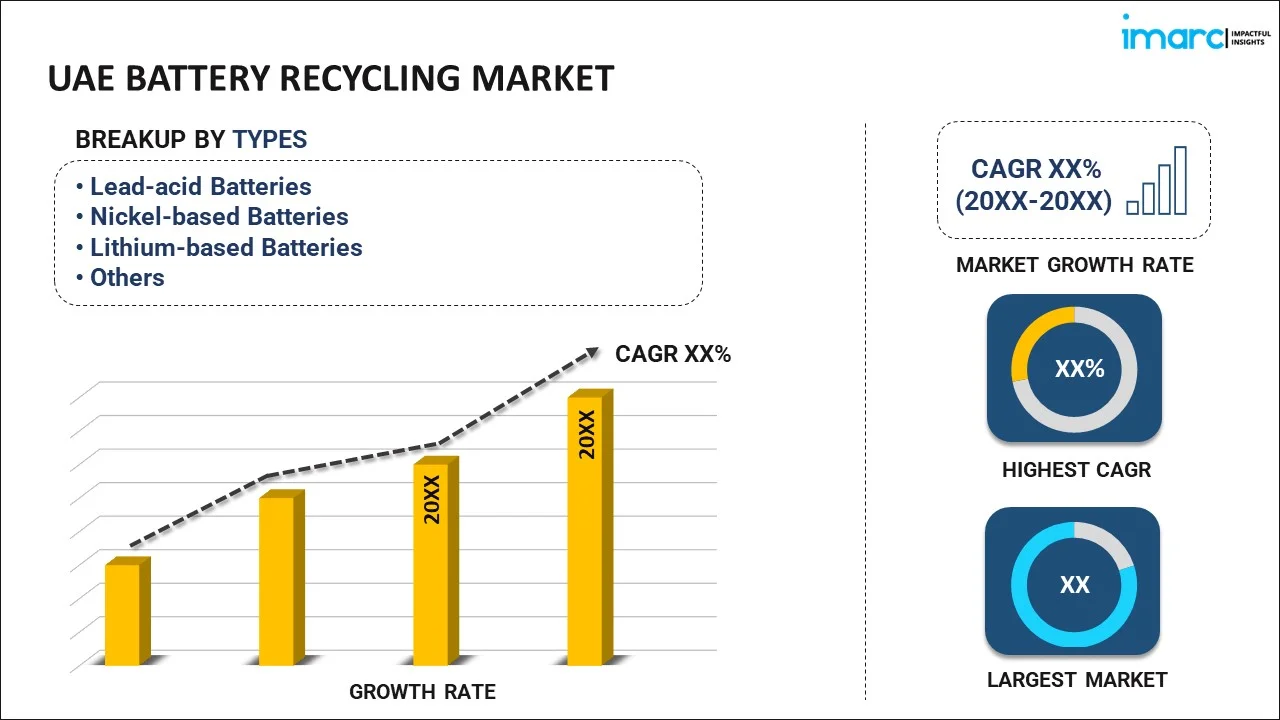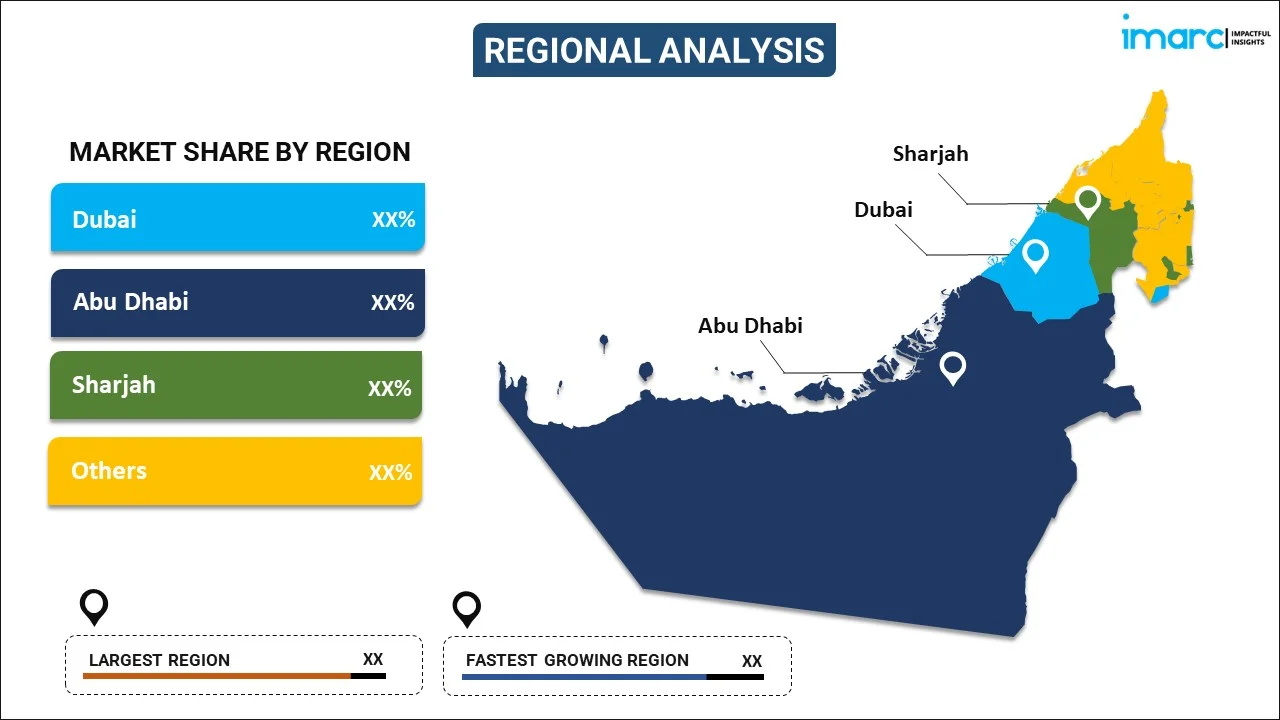
UAE Battery Recycling Market Report by Type (Lead-acid Batteries, Nickel-based Batteries, Lithium-based Batteries, and Others), Source (Industrial, Automotive, Consumer Products, Electronic Appliances, and Others), End Use (Reuse, Repackaging, Extraction, and Others), Material (Manganese, Lithium, Nickel, Cobalt, Lead, Aluminium, and Others), and Region 2024-2032
UAE Battery Recycling Market Overview:
The UAE battery recycling market is projected to exhibit a growth rate (CAGR) of 10.60% during 2024-2032. Stringent environmental regulations, increasing awareness of battery disposal hazards, and government sustainability initiatives are driving market growth. Additionally, the surging adoption of electric vehicles (EVs), rising demand for renewable energy storage, and technological advancements in recycling further contribute to the demand for battery recycling solutions.
|
Report Attribute
|
Key Statistics
|
|---|---|
|
Base Year
|
2023 |
|
Forecast Years
|
2024-2032
|
|
Historical Years
|
2018-2023
|
| Market Growth Rate (2024-2032) | 10.60% |
UAE Battery Recycling Market Trends:
Stringent Environmental Regulations
The UAE battery recycling market is mainly defined by the strict green initiatives that encourage eco-friendly modes of processing which eliminates pollution at a persistent rate, all of which makes UAE battery recycling market boast of a more eco-friendly and sustainable waste management industry. Understandably these regulations require the batteries to be disposed of or recycled properly to save the environment from the polluting effects of toxic materials contained in the batteries, such as lead, cadmium, and mercury. Moreover, businesses have an ethical and legal duty to comply with these regulations when conducting any business activity in the UAE. This puts pressure on companies to invest in battery recycling infrastructure and processes so that they are not fined or penalized. This has made it easier to grow the battery recycling market as these regulations encourage the different stakeholders to take up responsible waste management methods and fosters the implementation of the circular economy and the culture of environmental stewardship.
Increasing Awareness about Hazards of Improper Battery Disposal
Growing awareness regarding hazardous effects of incorrect battery disposal is escalating the requirement for recycling services in the UAE. Amid growing fears of environmental contamination and threats to human health posed by incinerating or landfilling batteries, consumers, corporations and policymakers are realizing the need for sustainable recycling. Public awareness campaigns, educational initiatives, and media coverage detailing the environmental and health effects of battery waste, have begun to make the end-of-life of batteries a more pertinent issue to a broader range of people and businesses in the adoption (or intention) of battery recycling programs. Such growing consciousness is increasingly empowering the market and the interested parties in learning about recycling to manage their battery disposal and associated environmental concerns in a more responsible fashion.
Government Initiatives Promoting Sustainable Practices
Government initiatives promoting sustainable practices play a pivotal role in shaping the UAE battery recycling market landscape. Recognizing the importance of transitioning towards a circular economy model and reducing dependence on finite resources, the UAE government has introduced various policies, incentives, and funding programs to encourage recycling and resource recovery efforts. These initiatives range from establishing regulatory frameworks and setting recycling targets to providing financial incentives and subsidies for investments in recycling infrastructure. By fostering collaboration between public and private sectors, these government-led initiatives create an enabling environment for innovation and investment in sustainable waste management solutions.
UAE Battery Recycling Market News:
- In 2023, BEEAH Recycling, in collaboration with the UAE Ministry of Energy and Infrastructure and the American University of Sharjah, announced the establishment of the UAE's first recycling facility for end-of-life electric vehicle (EV) batteries. This initiative aims to support the sustainable growth of the EV market by diverting landfill waste and enhancing material recovery. The facility will be integrated into BEEAH’s waste management complex in Sharjah, which already boasts a 76% waste diversion rate.
- In 2023, LOHUM Cleantech, in partnership with the Ministry of Energy and Infrastructure and BEEAH, launched an 80,000 sq ft facility in the UAE dedicated to refurbishing and recycling lithium-ion batteries. This facility, which will handle 3,000 tons of lithium-ion batteries annually, aims to repurpose 15MWh of battery capacity into sustainable energy storage systems each year.
UAE Battery Recycling Market Segmentation:
IMARC Group provides an analysis of the key trends in each segment of the market, along with forecasts at the country level for 2024-2032. Our report has categorized the market based on type, source, end use, and material.
Type Insights:

- Lead-acid Batteries
- Nickel-based Batteries
- Lithium-based Batteries
- Others
The report has provided a detailed breakup and analysis of the market based on the type. This includes lead-acid batteries, nickel-based batteries, lithium-based batteries, and others.
Source Insights:
- Industrial
- Automotive
- Consumer Products
- Electronic Appliances
- Others
A detailed breakup and analysis of the market based on the source have also been provided in the report. This includes industrial, automotive, consumer products, electronic appliances, and others.
End Use Insights:
- Reuse
- Repackaging
- Extraction
- Others
The report has provided a detailed breakup and analysis of the market based on the end use. This includes reuse, repackaging, extraction, and others.
Material Insights:
- Manganese
- Lithium
- Nickel
- Cobalt
- Lead
- Aluminium
- Others
A detailed breakup and analysis of the market based on the material have also been provided in the report. This includes manganese, lithium, nickel, cobalt, lead, aluminium, and others.
Regional Insights:

- Dubai
- Abu Dhabi
- Sharjah
- Others
The report has also provided a comprehensive analysis of all the major regional markets, which include Dubai, Abu Dhabi, Sharjah, and Others.
Competitive Landscape:
The market research report has also provided a comprehensive analysis of the competitive landscape. Competitive analysis such as market structure, key player positioning, top winning strategies, competitive dashboard, and company evaluation quadrant has been covered in the report. Also, detailed profiles of all major companies have been provided.
UAE Battery Recycling Market Report Coverage:
| Report Features | Details |
|---|---|
| Base Year of the Analysis | 2023 |
| Historical Period | 2018-2023 |
| Forecast Period | 2024-2032 |
| Units | Million US$ |
| Scope of the Report | Exploration of Historical and Forecast Trends, Industry Catalysts and Challenges, Segment-Wise Historical and Predictive Market Assessment:
|
| Types Covered | Lead-acid Batteries, Nickel-based Batteries, Lithium-based Batteries, Others |
| Sources Covered | Industrial, Automotive, Consumer Products, Electronic Appliances, Others |
| End Uses Covered | Reuse, Repackaging, Extraction, Others |
| Materials Covered | Manganese, Lithium, Nickel, Cobalt, Lead, Aluminium, Others |
| Regions Covered | Dubai, Abu Dhabi, Sharjah, Others |
| Customization Scope | 10% Free Customization |
| Post-Sale Analyst Support | 10-12 Weeks |
| Delivery Format | PDF and Excel through Email (We can also provide the editable version of the report in PPT/Word format on special request) |
Key Questions Answered in This Report:
- How has the UAE battery recycling market performed so far and how will it perform in the coming years?
- What has been the impact of COVID-19 on the UAE battery recycling market?
- What is the breakup of the UAE battery recycling market on the basis of type?
- What is the breakup of the UAE battery recycling market on the basis of source?
- What is the breakup of the UAE battery recycling market on the basis of end use?
- What is the breakup of the UAE battery recycling market on the basis of material?
- What are the various stages in the value chain of the UAE battery recycling market?
- What are the key driving factors and challenges in the UAE battery recycling?
- What is the structure of the UAE battery recycling market and who are the key players?
- What is the degree of competition in the UAE battery recycling market?
Key Benefits for Stakeholders:
- IMARC’s industry report offers a comprehensive quantitative analysis of various market segments, historical and current market trends, market forecasts, and dynamics of the UAE battery recycling market from 2018-2032.
- The research report provides the latest information on the market drivers, challenges, and opportunities in the UAE battery recycling market.
- Porter's five forces analysis assist stakeholders in assessing the impact of new entrants, competitive rivalry, supplier power, buyer power, and the threat of substitution. It helps stakeholders to analyze the level of competition within the UAE battery recycling industry and its attractiveness.
- Competitive landscape allows stakeholders to understand their competitive environment and provides an insight into the current positions of key players in the market.
Need more help?
- Speak to our experienced analysts for insights on the current market scenarios.
- Include additional segments and countries to customize the report as per your requirement.
- Gain an unparalleled competitive advantage in your domain by understanding how to utilize the report and positively impacting your operations and revenue.
- For further assistance, please connect with our analysts.
 Inquire Before Buying
Inquire Before Buying
 Speak to an Analyst
Speak to an Analyst
 Request Brochure
Request Brochure
 Request Customization
Request Customization




.webp)




.webp)












